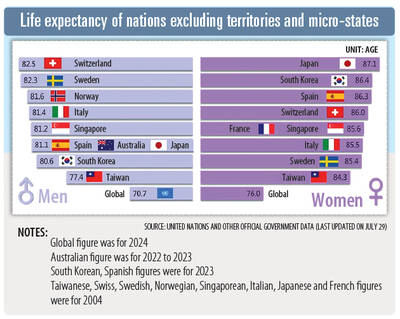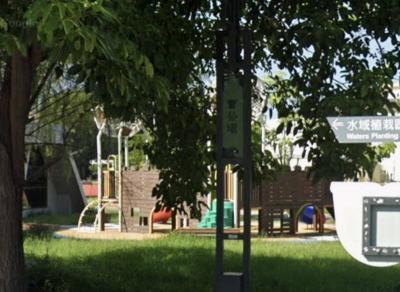An expert has warned against eating poisonous fungi after a hiker spotted what he thought was the world’s deadliest fungi, called poison fire coral, but which turned out to be a less harmful species, Clavulinopsis miyabeana.
A hiker surnamed Lee (李) on Saturday said that he took a photograph of a cluster of red fungi he saw on his way to Gaoyaoshan (高腰山) in New Taipei City’s Wulai District (烏來) last month.
After discussing the picture with a retired science teacher, they concluded that it looked like poison fire coral, also known as Podostroma cornu-damae, which is native to Japan, but has been found as far away as Australia.

Photo courtesy of hiker surnamed Lee
Lee became concerned that people might pick the bright red fungus for consumption.
Fungus expert Lin Tzu-chao (林子超), who published a paper on poison fire coral as a new species in Taiwan, said that the fungus in the picture Lee took is likely Clavulinopsis miyabeana, based on its appearance.
Poison fire coral has rodlike, solid, fleshy and reddish orange stromata that point upward and are white inside, Lin said, adding that they are 6cm to 10cm in height and 0.7cm to 1cm in diameter.
Clavulinopsis miyabeana is different in that it is hollow and rodlike, and 3cm to 4cm tall, he said.
Poison fire coral, a type of saprophytic fungus, grows in scattered patterns on the ground beneath broad-leaved trees, and its spores are dispersed by wind, Lin said.
It has been found in China, South Korea, and on Orchid Island (Lanyu, 蘭嶼), but not on Taiwan proper, he said.
While touching poison fire coral is not harmful, it must not be eaten, he said.
There was a case in South Korea of two people drinking water cooked with wild lingzhi mushroom they gathered without knowing that it contained a piece of poison fire coral, Lin said.
One died and the other suffered from desquamation of skin on the palms and soles, severe septicemia and organ failure, he said.
Consuming any type of poisonous fungus can cause vomiting, diarrhea and hallucinations, while poison fire coral additionally causes severe liver damage, he said.
There is no antidote for the poison, so those who have consumed it can only be treated with supportive therapy, he added.

The inspection equipment and data transmission system for new robotic dogs that Taipei is planning to use for sidewalk patrols were developed by a Taiwanese company, the city’s New Construction Office said today, dismissing concerns that the China-made robots could pose a security risk. The city is bringing in smart robotic dogs to help with sidewalk inspections, Taipei Deputy Mayor Lee Ssu-chuan (李四川) said on Facebook. Equipped with a panoramic surveillance system, the robots would be able to automatically flag problems and easily navigate narrow sidewalks, making inspections faster and more accurate, Lee said. By collecting more accurate data, they would help Taipei

STATS: Taiwan’s average life expectancy of 80.77 years was lower than that of Japan, Singapore and South Korea, but higher than in China, Malaysia and Indonesia Taiwan’s average life expectancy last year increased to 80.77 years, but was still not back to its pre-COVID-19 pandemic peak of 81.32 years in 2020, the Ministry of the Interior said yesterday. The average life expectancy last year increased the 0.54 years from 2023, the ministry said in a statement. For men and women, the average life expectancy last year was 77.42 years and 84.30 years respectively, up 0.48 years and 0.56 years from the previous year. Taiwan’s average life expectancy peaked at 81.32 years in 2020, as the nation was relatively unaffected by the pandemic that year. The metric

TAKING STOCK: The USMC is rebuilding a once-abandoned airfield in Palau to support large-scale ground operations as China’s missile range grows, Naval News reported The US Marine Corps (USMC) is considering new sites for stockpiling equipment in the West Pacific to harden military supply chains and enhance mobility across the Indo-Pacific region, US-based Naval News reported on Saturday. The proposed sites in Palau — one of Taiwan’s diplomatic allies — and Australia would enable a “rapid standup of stored equipment within a year” of the program’s approval, the report said, citing documents published by the USMC last month. In Palau, the service is rebuilding a formerly abandoned World War II-era airfield and establishing ancillary structures to support large-scale ground operations “as China’s missile range and magazine

A 72-year-old man in Kaohsiung was sentenced to 40 days in jail after he was found having sex with a 67-year-old woman under a slide in a public park on Sunday afternoon. At 3pm on Sunday, a mother surnamed Liang (梁) was with her child at a neighborhood park when they found the man, surnamed Tsai (蔡), and woman, surnamed Huang (黃), underneath the slide. Liang took her child away from the scene, took photographs of the two and called the police, who arrived and arrested the couple. During questioning, Tsai told police that he had met Huang that day and offered to